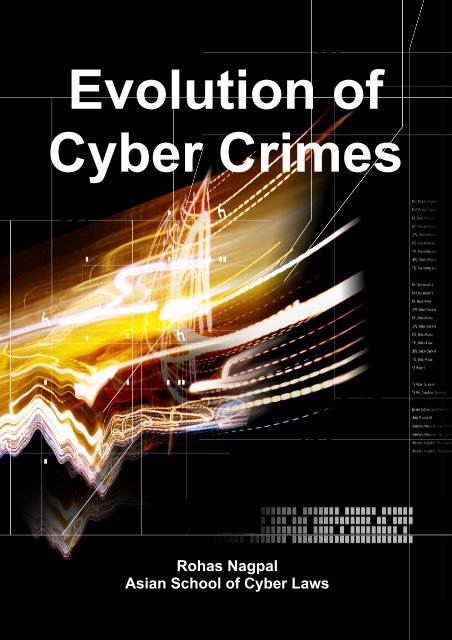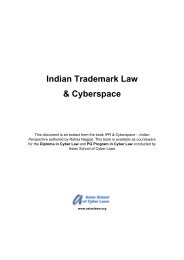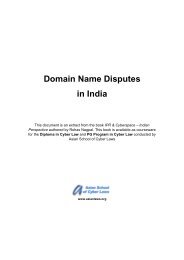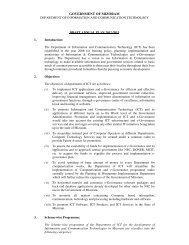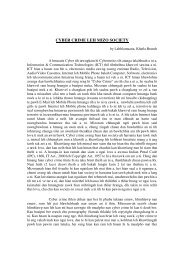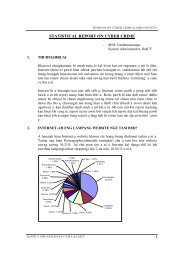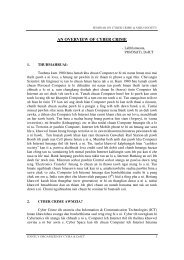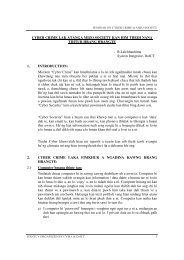Rohas Nagpal Asian School of Cyber Laws - Department of ...
Rohas Nagpal Asian School of Cyber Laws - Department of ...
Rohas Nagpal Asian School of Cyber Laws - Department of ...
You also want an ePaper? Increase the reach of your titles
YUMPU automatically turns print PDFs into web optimized ePapers that Google loves.
Evolution <strong>of</strong><strong>Cyber</strong> Crimes<strong>Rohas</strong> <strong>Nagpal</strong><strong>Asian</strong> <strong>School</strong> <strong>of</strong> <strong>Cyber</strong> <strong>Laws</strong>
About the author<strong>Rohas</strong> <strong>Nagpal</strong> is the founder President <strong>of</strong> <strong>Asian</strong> <strong>School</strong> <strong>of</strong><strong>Cyber</strong> <strong>Laws</strong>.He advises Governments and corporates around the worldin cyber crime investigation and cyber law related issues.He has assisted the Government <strong>of</strong> India in drafting rulesand regulations under the Information Technology Act,2000.He has authored several books, papers and articles oncyber law, cyber terrorism, cyber crime investigation andfinancial law.<strong>Rohas</strong> lives in Pune (India) and blogs @ rohasnagpal.comSome <strong>of</strong> the papers authored by <strong>Rohas</strong> <strong>Nagpal</strong>1. Internet Time Theft & the Indian Law2. Legislative Approach to Digital Signatures3. Indian Legal position on <strong>Cyber</strong> Terrorism4. Defining <strong>Cyber</strong> Terrorism5. The mathematics <strong>of</strong> terror6. <strong>Cyber</strong> Terrorism in the context <strong>of</strong> Globalisation7. Biometric based Digital Signature SchemeSome <strong>of</strong> the books authored by <strong>Rohas</strong> <strong>Nagpal</strong>
<strong>Asian</strong> <strong>School</strong> <strong>of</strong> <strong>Cyber</strong> <strong>Laws</strong>1. EVOLUTION OF CYBER CRIME ........................................................................... 21.1 FINANCIAL CRIMES................................................................................................ 31.2 CYBER PORNOGRAPHY......................................................................................... 51.3 SALE OF ILLEGAL ARTICLES................................................................................. 61.4 ONLINE GAMBLING................................................................................................ 71.5 INTELLECTUAL PROPERTY CRIMES ...................................................................... 81.6 EMAIL SPOOFING................................................................................................... 91.7 FORGERY ............................................................................................................. 101.8 CYBER DEFAMATION........................................................................................... 111.9 CYBER STALKING................................................................................................ 121.10 WEB DEFACEMENT............................................................................................ 141.11 EMAIL BOMBING................................................................................................ 161.12 DATA DIDDLING................................................................................................. 171.13 SALAMI ATTACKS.............................................................................................. 181.14 DENIAL OF SERVICE ATTACK ........................................................................... 201.15 VIRUS / WORM ATTACKS .................................................................................. 211.16 TROJANS AND KEYLOGGERS............................................................................ 241.17 INTERNET TIME THEFT ...................................................................................... 251.18 WEB JACKING ................................................................................................... 261.19 EMAIL FRAUDS.................................................................................................. 291.20 CYBER TERRORISM........................................................................................... 321.21 USE OF ENCRYPTION BY TERRORISTS .............................................................. 36© 2008 <strong>Rohas</strong> <strong>Nagpal</strong>. All rights reserved. - 1 -
<strong>Asian</strong> <strong>School</strong> <strong>of</strong> <strong>Cyber</strong> <strong>Laws</strong>1. Evolution <strong>of</strong> cyber crimeThe first recorded cyber crime took place in the year 1820!That is not surprising considering the fact that the abacus, which isthought to be the earliest form <strong>of</strong> a computer, has been around since3500 B.C. in India, Japan and China. The era <strong>of</strong> modern computers,however, began with the analytical engine <strong>of</strong> Charles Babbage.In 1820, Joseph-Marie Jacquard, a textile manufacturer in France,produced the loom. This device allowed the repetition <strong>of</strong> a series <strong>of</strong> stepsin the weaving <strong>of</strong> special fabrics. This resulted in a fear amongstJacquard's employees that their traditional employment and livelihoodwere being threatened. They committed acts <strong>of</strong> sabotage to discourageJacquard from further use <strong>of</strong> the new technology. This is the firstrecorded cyber crime!Today, computers have come a long way with neural networks and nanocomputingpromising to turn every atom in a glass <strong>of</strong> water into acomputer capable <strong>of</strong> performing a billion operations per second.In a day and age when everything from microwave ovens andrefrigerators to nuclear power plants are being run on computers, cybercrime has assumed rather sinister implications.<strong>Cyber</strong> crime can involve criminal activities that are traditional in nature,such as theft, fraud, forgery, defamation and mischief. The abuse <strong>of</strong>computers has also given birth to a gamut <strong>of</strong> new age crimes such ashacking, web defacement, cyber stalking, web jacking etc.A simple yet sturdy definition <strong>of</strong> cyber crime would be “unlawful actswherein the computer is either a tool or a target or both”.The term computer used in thisdefinition does not only mean theconventional desktop or laptopcomputer. It includes PersonalDigital Assistants (PDA), cellphones, sophisticated watches, carsand a host <strong>of</strong> gadgets.Recent global cyber crime incidents like the targeted denial <strong>of</strong> serviceattacks on Estonia have heightened fears. Intelligence agencies arepreparing against coordinated cyber attacks that could disrupt rail and airtraffic controls, electricity distribution networks, stock markets, bankingand insurance systems etc.Unfortunately, it is not possible to calculate the true social and financialimpact <strong>of</strong> cyber crime. This is because most crimes go unreported.- 2 - © 2008 <strong>Rohas</strong> <strong>Nagpal</strong>. All rights reserved.
<strong>Asian</strong> <strong>School</strong> <strong>of</strong> <strong>Cyber</strong> <strong>Laws</strong>1.1 Financial CrimesMoney is the most common motive behind all crime. The same is alsotrue for cyber crime. Globally it is being observed that more and morecyber crimes are being committed for financial motives rather than for“revenge” or for “fun”.With the tremendous increase in the use <strong>of</strong> internet and mobile banking,online share trading, dematerialization <strong>of</strong> shares and securities, this trendis likely to increase unabated.Financial crimes include cyber cheating, credit card frauds, moneylaundering, hacking into bank servers, computer manipulation,accounting scams etc.Illustration 1Punjab National Bank in India wascheated to the tune <strong>of</strong> Rs. 13.9million through false debits andcredits in computerized accounts.Illustration 2Rs. 2,50,000 were misappropriatedfrom Bank <strong>of</strong> Baroda in Indiathrough falsification <strong>of</strong> computerizedbank accounts.Illustration 3The Hyderabad police in Indiaarrested an unemployed computeroperator and his friend, a steward ina prominent five-star hotel, forstealing and misusing credit cardnumbers belonging to hotelcustomers.The steward noted down thevarious details <strong>of</strong> the credit cards,which were handed by clients <strong>of</strong> thehotel for paying their bills. Then, hepassed all the details to hiscomputer operator friend who usedthe details to make onlinepurchases on various websites.Illustration 4In 2004, the US Secret Serviceinvestigated and shut down anonline organization that trafficked inaround 1.7 million stolen creditcards and stolen identity informationand documents.© 2008 <strong>Rohas</strong> <strong>Nagpal</strong>. All rights reserved. - 3 -
<strong>Asian</strong> <strong>School</strong> <strong>of</strong> <strong>Cyber</strong> <strong>Laws</strong>This high-pr<strong>of</strong>ile case, known as“Operation Firewall,” focused on acriminal organization <strong>of</strong> some 4,000members whose Web sitefunctioned as a hub for identity theftactivity.Illustration 5In 2003, a hacker was convicted inthe USA for causing losses <strong>of</strong>almost $25 million. The defendantpleaded guilty to numerous charges<strong>of</strong> conspiracy, computer intrusion,computer fraud, credit card fraud,wire fraud, and extortion.The hacker and his accomplicesfrom Russia had stolen usernames,passwords, credit card information,and other financial data by hackinginto computers <strong>of</strong> US citizens. Theywould then extort money from thosevictims with the threat <strong>of</strong> deletingtheir data and destroying theircomputer systems.- 4 - © 2008 <strong>Rohas</strong> <strong>Nagpal</strong>. All rights reserved.
<strong>Asian</strong> <strong>School</strong> <strong>of</strong> <strong>Cyber</strong> <strong>Laws</strong>1.2 <strong>Cyber</strong> Pornography<strong>Cyber</strong> pornography is believed to be one <strong>of</strong> the largest businesses on theInternet today. The millions <strong>of</strong> pornographic websites that flourish on theInternet are testimony to this. While pornography per se is not illegal inmany countries, child pornography is strictly illegal in most nations today.<strong>Cyber</strong> pornography covers pornographic websites, pornographicmagazines produced using computers (to publish and print the material)and the Internet (to download and transmit pornographic pictures,photos, writings etc).Illustration 1A school student from Delhi (India),who was regularly teased for havinga pockmarked face, used a freehosting provider to createwww.amazing-gents.8m.net.He regularly uploaded “morphed”photographs <strong>of</strong> teachers and girlsfrom his school onto the website.He was arrested when the father <strong>of</strong>one <strong>of</strong> the victims reported the caseto the police.Illustration 2The CEO <strong>of</strong> online auction websitebazee.com (a part <strong>of</strong> the ebaygroup) was arrested by the Delhipolice for violating India’s strict lawson cyber pornography. Anengineering student was using thebazee website to sell a videodepicting two school studentshaving sexual intercourse.Bazee.com was held liable fordistributing porn and hence theCEO was arrested.Illustration 3The CEO <strong>of</strong> a s<strong>of</strong>tware company inPune (India) was arrested forsending highly obscene emails to aformer employee.© 2008 <strong>Rohas</strong> <strong>Nagpal</strong>. All rights reserved. - 5 -
<strong>Asian</strong> <strong>School</strong> <strong>of</strong> <strong>Cyber</strong> <strong>Laws</strong>1.3 Sale <strong>of</strong> Illegal ArticlesIt is becoming increasingly common to find cases where sale <strong>of</strong> illegalarticles such as narcotics drugs, weapons, wildlife etc. is being facilitatedby the Internet. Information about the availability <strong>of</strong> the products for saleis being posted on auction websites, bulletin boards etc.It is practically impossible to controlor prevent a criminal from setting upa website to transact in illegalarticles. Additionally, there areseveral online payment gatewaysthat can transfer money around theworld at the click <strong>of</strong> a button.The Internet has also created a marketplace for the sale <strong>of</strong> unapproveddrugs, prescription drugs dispensed without a valid prescription, orproducts marketed with fraudulent health claims.Many sites focus on sellingprescription drugs and are referredto by some as “Internetpharmacies.” These sites <strong>of</strong>fer forsale either approved prescriptiondrug products, or in some cases,unapproved, illegal versions <strong>of</strong>prescription drugs. This poses aserious potential threat to the healthand safety <strong>of</strong> patients.The broad reach, relativeanonymity, and ease <strong>of</strong> creatingnew or removing old websites,poses great challenges for lawenforcement <strong>of</strong>ficials.IllustrationIn March 2007, the Pune ruralpolice cracked down on an illegalrave party and arrested hundreds <strong>of</strong>illegal drug users. The socialnetworking site Orkut.com isbelieved to be one <strong>of</strong> the modes <strong>of</strong>communication for gathering peoplefor the illegal “drug” party.- 6 - © 2008 <strong>Rohas</strong> <strong>Nagpal</strong>. All rights reserved.
<strong>Asian</strong> <strong>School</strong> <strong>of</strong> <strong>Cyber</strong> <strong>Laws</strong>1.4 Online GamblingThere are thousands <strong>of</strong> websites that <strong>of</strong>fer online gambling. The specialissue with online gambling is that it is legalised in several countries. Solegally the owners <strong>of</strong> these websites are safe in their home countries.The legal issues arise when a person residing in a foreign country likeIndia (where such websites are illegal) gambles on such a website.IllustrationThe website ladbrokes.compermits users to gamble on avariety <strong>of</strong> sports such as cricket,football, tennis, golf, motor racing,ice hockey, basketball, baseball,darts, snooker, boxing, athletics,rugby, volleyball, motor cycling etc.Additionally it also features anonline casino. The website has notechnical measures in place toprohibit residents <strong>of</strong> certaincountries (where online gambling isillegal) from betting at their website.© 2008 <strong>Rohas</strong> <strong>Nagpal</strong>. All rights reserved. - 7 -
<strong>Asian</strong> <strong>School</strong> <strong>of</strong> <strong>Cyber</strong> <strong>Laws</strong>1.5 Intellectual Property CrimesThese include s<strong>of</strong>tware piracy, copyright infringement, trademarksviolations, theft <strong>of</strong> computer source code etc.Illustration 1A s<strong>of</strong>tware pr<strong>of</strong>essional fromBangalore (India) was booked forstealing the source code <strong>of</strong> aproduct being developed by hisemployers. He started his owncompany and allegedly used thestolen source code to launch a news<strong>of</strong>tware product.Illustration 2In 2003, a computer user in Chinaobtained the source code <strong>of</strong> apopular game - LineageII from anunprotected website. Thisproprietary code was then sold toseveral people in 2004. One <strong>of</strong>those people set up a website,www.l2extreme.com, to <strong>of</strong>fer the“Lineage” game at a discount.Despite legal warnings from theSouth Korean company that ownedthe Lineage source code, thesuspect did not shut down the site.He rented powerful servers -enough to accommodate 4,000simultaneous gamers - and soliciteddonations from users to help defraythe costs.The loss in potential revenues forthe South Korean company wasestimated at $750,000 a month. TheUS FBI arrested the suspect andthe website was shut down.- 8 - © 2008 <strong>Rohas</strong> <strong>Nagpal</strong>. All rights reserved.
<strong>Asian</strong> <strong>School</strong> <strong>of</strong> <strong>Cyber</strong> <strong>Laws</strong>1.6 Email Spo<strong>of</strong>ingA spo<strong>of</strong>ed email is one that appears to originate from one source butactually has been sent from another source e.g Pooja has an e-mailaddress pooja@asianlaws.org.Her ex-boyfriend, Sameer spo<strong>of</strong>s her e-mail and sends obscenemessages to all her acquaintances. Since the e-mails appear to haveoriginated from Pooja, her friends may take <strong>of</strong>fence and relationshipsmay be spoiled for life.Illustration 1In an American case, a teenagermade millions <strong>of</strong> dollars byspreading false information aboutcertain companies whose shares hehad short sold.This misinformation was spread bysending spo<strong>of</strong>ed emails, purportedlyfrom news agencies like Reuters, toshare brokers and investors whowere informed that the companieswere doing very badly.Even after the truth came out thevalues <strong>of</strong> the shares did not go backto the earlier levels and thousands<strong>of</strong> investors lost a lot <strong>of</strong> money.Illustration 2A branch <strong>of</strong> the erstwhile GlobalTrust Bank in India experienced arun on the bank. Numerouscustomers decided to withdraw alltheir money and close theiraccounts.An investigation revealed thatsomeone had sent out spo<strong>of</strong>edemails to many <strong>of</strong> the bank’scustomers stating that the bank wasin very bad shape financially andcould close operations at any time.The spo<strong>of</strong>ed email appeared tohave originated from the bank itself.© 2008 <strong>Rohas</strong> <strong>Nagpal</strong>. All rights reserved. - 9 -
<strong>Asian</strong> <strong>School</strong> <strong>of</strong> <strong>Cyber</strong> <strong>Laws</strong>1.7 ForgeryCounterfeit currency notes, postage and revenue stamps, mark sheets,academic certificates etc are made by criminals using sophisticatedcomputers, printers and scanners.Illustration 1In October 1995, EconomicOffences Wing <strong>of</strong> Crime Branch,Mumbai (India), seized over 22,000counterfeit share certificates <strong>of</strong> eightreputed companies worth Rs. 34.47crores. These were allegedlyprepared using Desk TopPublishing Systems.Illustration 2Abdul Kareem Telgi, along withseveral others, was convicted inIndia on several counts <strong>of</strong>counterfeiting stamp papers andpostage stamps totalling severalbillion rupees.- 10 - © 2008 <strong>Rohas</strong> <strong>Nagpal</strong>. All rights reserved.
<strong>Asian</strong> <strong>School</strong> <strong>of</strong> <strong>Cyber</strong> <strong>Laws</strong>1.8 <strong>Cyber</strong> DefamationThis occurs when defamation takes place with the help <strong>of</strong> computers and/ or the Internet. e.g. Sameer publishes defamatory matter about Poojaon a website or sends e-mails containing defamatory information toPooja’s friends.Illustration 1Abhishek, a teenaged student wasarrested by the Thane police inIndia following a girl’s complaintabout tarnishing her image in thesocial networking site Orkut.Abhishek had allegedly created afake account in the name <strong>of</strong> the girlwith her mobile number posted onthe pr<strong>of</strong>ile.The pr<strong>of</strong>ile had been sketched insuch a way that it drew lewdcomments from many who visitedher pr<strong>of</strong>ile. The Thane <strong>Cyber</strong> Celltracked down Abhishek from thefalse e-mail id that he had createdto open up the account.Illustration 2The Aurangabad bench <strong>of</strong> theBombay high court issued a noticeto Google.com following a publicinterest litigation initiated by ayoung lawyer.The lawyer took exception to acommunity called ‘We hate India’,owned by someone who identifiedhimself as Miroslav Stankovic. Thecommunity featured a picture <strong>of</strong> theIndian flag being burnt.Illustration 3Unidentified persons postedobscene photographs and contactdetails <strong>of</strong> a Delhi school girl.Suggestive names like ’sex teacher’were posted on the pr<strong>of</strong>ile.The matter came to light after thegirl’s family started receiving vulgarcalls referring to Orkut.© 2008 <strong>Rohas</strong> <strong>Nagpal</strong>. All rights reserved. - 11 -
<strong>Asian</strong> <strong>School</strong> <strong>of</strong> <strong>Cyber</strong> <strong>Laws</strong>1.9 <strong>Cyber</strong> Stalking<strong>Cyber</strong> stalking refers to the use <strong>of</strong> the Internet, e-mail, or other electroniccommunications devices to stalk another person.Stalking generally involves harassing or threatening behaviour that anindividual engages in repeatedly, such as following a person, appearingat a person's home or place <strong>of</strong> business, making harassing phone calls,leaving written messages or objects, or vandalizing a person's property.Most stalking laws require that the perpetrator make a credible threat <strong>of</strong>violence against the victim; others include threats against the victim'simmediate family.Illustration 1In the first successful prosecutionunder the California (USA) cyberstalking law, prosecutors obtained aguilty plea from a 50-year-oldformer security guard who used theInternet to solicit the rape <strong>of</strong> awoman who rejected his romanticadvances.He terrorized the 28-year-old victimby impersonating her in variousInternet chat rooms and onlinebulletin boards, where he posted,along with her telephone numberand address, messages that shefantasized about being raped.On at least six occasions,sometimes in the middle <strong>of</strong> thenight, men knocked on the woman'sdoor saying they wanted to rapeher.Illustration 2An honours graduate from theUniversity <strong>of</strong> San Diego in USAterrorized five female universitystudents over the Internet for morethan a year.The victims received hundreds <strong>of</strong>violent and threatening e-mails,sometimes receiving four or fivemessages a day.The student, who pleaded guilty,told the police that he had- 12 - © 2008 <strong>Rohas</strong> <strong>Nagpal</strong>. All rights reserved.
<strong>Asian</strong> <strong>School</strong> <strong>of</strong> <strong>Cyber</strong> <strong>Laws</strong>committed the crimes because hethought the women were laughingat him and causing others to ridiculehim. In reality, the victims had nevermet him.Illustration 3In 2005, a minor fromMassachusetts (USA) wasconvicted in connection withapproximately $1 million in victimdamages.Over a 15-month period, he hadhacked into Internet and telephoneservice providers, stolen anindividual’s personal informationand posted it on the Internet, andmade bomb threats to many highschools.© 2008 <strong>Rohas</strong> <strong>Nagpal</strong>. All rights reserved. - 13 -
<strong>Asian</strong> <strong>School</strong> <strong>of</strong> <strong>Cyber</strong> <strong>Laws</strong>1.10 Web defacementWebsite defacement is usually the substitution <strong>of</strong> the original home page<strong>of</strong> a website with another page (usually pornographic or defamatory innature) by a hacker.Religious and government sites are regularly targeted by hackers inorder to display political or religious beliefs. Disturbing images and<strong>of</strong>fensive phrases might be displayed in the process, as well as asignature <strong>of</strong> sorts, to show who was responsible for the defacement.Websites are not only defaced for political reasons, many defacers do itjust for the thrill. For example, there are online contests in which hackersare awarded points for defacing the largest number <strong>of</strong> web sites in aspecified amount <strong>of</strong> time. Corporations are also targeted more <strong>of</strong>ten thanother sites on the Internet and they <strong>of</strong>ten seek to take measures toprotect themselves from defacement or hacking in general.Web sites represent the image <strong>of</strong> a company or organisation and theseare therefore especially vulnerable to defacement. Visitors may lose faithin sites that cannot promise security and will become wary <strong>of</strong> performingonline transactions. After defacement, sites have to be shut down forrepairs, sometimes for an extended period <strong>of</strong> time, causing expensesand loss <strong>of</strong> pr<strong>of</strong>it.Illustration 1Mahesh Mhatre and Anand Khare(alias Dr Neukar) were arrested in2002 for allegedly defacing thewebsite <strong>of</strong> the Mumbai <strong>Cyber</strong> CrimeCell.They had allegedly used passwordcracking s<strong>of</strong>tware to crack the FTPpassword for the police website.They then replaced the homepage<strong>of</strong> the website with pornographiccontent. The duo was also chargedwith credit card fraud for using 225credit card numbers, mostlybelonging to American citizens.Illustration 2In 2001, over 200 Indian websiteswere hacked into and defaced. Thehackers put in words like bugz,death symbol, Paki-king andallahhuakbar.In the case <strong>of</strong> 123medicinindia.com,a message was left behind whichsaid – “Catch me if uuu can my- 14 - © 2008 <strong>Rohas</strong> <strong>Nagpal</strong>. All rights reserved.
<strong>Asian</strong> <strong>School</strong> <strong>of</strong> <strong>Cyber</strong> <strong>Laws</strong>deraz lazy adminzzz” – challengingthe system administrators to tracethe miscreants.The <strong>of</strong>fenders were allegedly agroup <strong>of</strong> hackers who go by thename <strong>of</strong> ‘Pakistani <strong>Cyber</strong> Warriors’.Illustration 3In 2006, a Turkish hacker using thehandle iSKORPiTX was able tobreach the security <strong>of</strong> a group <strong>of</strong>web servers, containing more than38,500 web sites in less than a day!Illustration 4The first Defacers Challenge tookplace on Sunday, July 6, 2003.There was a special prize for thefirst contestant to deface 6,000 websites.The contest was conducted over asix-hour period. Points wereawarded based on the server’soperating system.Windows: 1 point,Linux: 2 points,BSD: 2 points,AIX: 3 points,HP-UX: 5 pointsMacintosh: 5 points© 2008 <strong>Rohas</strong> <strong>Nagpal</strong>. All rights reserved. - 15 -
<strong>Asian</strong> <strong>School</strong> <strong>of</strong> <strong>Cyber</strong> <strong>Laws</strong>1.11 Email BombingEmail bombing refers to sending a large number <strong>of</strong> emails to the victimresulting in the victim’s email account (in case <strong>of</strong> an individual) or mailservers (in case <strong>of</strong> a company or an email service provider) crashing.Email bombing is a type <strong>of</strong> denial-<strong>of</strong>-service attack. A denial-<strong>of</strong>-serviceattack is one in which a flood <strong>of</strong> information requests is sent to a server,bringing the system to its knees and making the server difficult to access.Illustration 1A British teenager was cleared <strong>of</strong>launching a denial-<strong>of</strong>-service attackagainst his former employer, in aruling under the UK ComputerMisuse Act.The teenager was accused <strong>of</strong>sending 5 million e-mail messagesto his ex-employer that caused thecompany's e-mail server to crash.The judge held that the UKComputer Misuse Act does notspecifically include a denial-<strong>of</strong>serviceattack as a criminal <strong>of</strong>fence.Illustration 2In one case, a foreigner who hadbeen residing in Simla, India foralmost 30 years wanted to avail <strong>of</strong> ascheme introduced by the SimlaHousing Board to buy land at lowerrates. When he made an applicationit was rejected on the grounds thatthe scheme was available only forcitizens <strong>of</strong> India.He decided to take his revenge.Consequently, he sent thousands <strong>of</strong>mails to the Simla Housing Boardand repeatedly kept sending e-mailstill their servers crashed.- 16 - © 2008 <strong>Rohas</strong> <strong>Nagpal</strong>. All rights reserved.
<strong>Asian</strong> <strong>School</strong> <strong>of</strong> <strong>Cyber</strong> <strong>Laws</strong>1.12 Data DiddlingOne <strong>of</strong> the most common forms <strong>of</strong> computer crime is data diddling -illegal or unauthorized data alteration. These changes can occur beforeand during data input or before output. Data diddling cases have affectedbanks, payrolls, inventory records, credit records, school transcripts andvirtually all other forms <strong>of</strong> data processing known.Illustration 1The NDMC Electricity Billing FraudCase that took place in 1996 is atypical example. The computernetwork was used for receipt andaccounting <strong>of</strong> electricity bills by theNew Delhi Municipal Council.Collection <strong>of</strong> money, computerizedaccounting, record maintenanceand remittance in the bank wereexclusively left to a privatecontractor who was a computerpr<strong>of</strong>essional.He misappropriated huge amount <strong>of</strong>funds by manipulating data files toshow less receipt and bankremittance.Illustration 2A keyboard operator processingorders at an Oakland USAdepartment store changed somedelivery addresses and divertedseveral thousand dollars worth <strong>of</strong>store goods into the hands <strong>of</strong>accomplices.Illustration 3A ticket clerk at the ArizonaVeterans' Memorial Coliseum inUSA issued full-price basketballtickets, sold them and then, tappingout codes on her computerkeyboard, recorded the transactionsas half-price sales.© 2008 <strong>Rohas</strong> <strong>Nagpal</strong>. All rights reserved. - 17 -
<strong>Asian</strong> <strong>School</strong> <strong>of</strong> <strong>Cyber</strong> <strong>Laws</strong>1.13 Salami AttacksThese attacks are used for committing financial crimes. The key here isto make the alteration so insignificant that in a single case it would gocompletely unnoticed.For instance, a bank employee inserts a program, into the bank’sservers, that deducts a small amount <strong>of</strong> money (say Rs. 2 a month) fromthe account <strong>of</strong> every customer. No account holder will probably noticethis unauthorized debit, but the bank employee will make a sizeableamount <strong>of</strong> money every month.The attack is called “salami attack” as it is analogous to slicing the datathinly, like a salami.Illustration 1Four executives <strong>of</strong> a rental-carfranchise in Florida USA defraudedat least 47,000 customers using asalami technique.They modified a computer billingprogram to add five extra gallons tothe actual gas tank capacity <strong>of</strong> theirvehicles.From 1988 through 1991, everycustomer who returned a carwithout topping it <strong>of</strong>f ended uppaying inflated rates for an inflatedtotal <strong>of</strong> gasoline.The thefts ranged from $2 to $15per customer - difficult for thevictims to detect.Illustration 2In January 1997, Willis Robinson <strong>of</strong>Maryland USA, was sentenced to10 years in prison for “havingreprogrammed his Taco Bell driveup-windowcash register - causing itto ring up each $2.99 item internallyas a 1-cent item, so that he couldpocket $2.98 each time”.The management assumed theerror was hardware or s<strong>of</strong>tware andonly caught the perpetrator when hebragged about his crime to coworkers.- 18 - © 2008 <strong>Rohas</strong> <strong>Nagpal</strong>. All rights reserved.
<strong>Asian</strong> <strong>School</strong> <strong>of</strong> <strong>Cyber</strong> <strong>Laws</strong>Illustration 3In Los Angeles USA four men werecharged with fraud for allegedlyinstalling computer chips in gasolinepumps that cheated consumers byoverstating the amounts pumped.The problem came to light when anincreasing number <strong>of</strong> consumersclaimed that they had been soldmore gasoline than the capacity <strong>of</strong>their gas tanks!However, the fraud was difficult toprove initially because theperpetrators programmed the chipsto deliver exactly the right amount <strong>of</strong>gasoline when asked for five- and10-gallon amounts (precisely theamounts typically used byinspectors).© 2008 <strong>Rohas</strong> <strong>Nagpal</strong>. All rights reserved. - 19 -
<strong>Asian</strong> <strong>School</strong> <strong>of</strong> <strong>Cyber</strong> <strong>Laws</strong>1.14 Denial <strong>of</strong> Service AttackDenial <strong>of</strong> Service attacks (DOS attacks) involve flooding a computer withmore requests than it can handle. This causes the computer (e.g. a webserver) to crash and results in authorized users being unable to accessthe service <strong>of</strong>fered by the computer.Another variation to a typical denial <strong>of</strong> service attack is known as aDistributed Denial <strong>of</strong> Service (DDoS) attack wherein the perpetrators aremany and are geographically widespread.Illustration 1A series <strong>of</strong> distributed denial <strong>of</strong>service attacks in February 2000crippled many popular websitesincluding yahoo.com, amazon.comand cnn.comIllustration 2A series <strong>of</strong> more than 125 separatebut coordinated denial <strong>of</strong> serviceattacks hit the cyber infrastructure<strong>of</strong> Estonia in early 2007.The attacks were apparentlyconnected with protests against theEstonian government's decision toremove a Soviet-era war memorialfrom the capital city.It is suspected that the attacks werecarried out by Russian hackers. Theattack lasted several days.- 20 - © 2008 <strong>Rohas</strong> <strong>Nagpal</strong>. All rights reserved.
<strong>Asian</strong> <strong>School</strong> <strong>of</strong> <strong>Cyber</strong> <strong>Laws</strong>1.15 Virus / Worm AttacksComputer viruses are small s<strong>of</strong>tware programs that are designed tospread from one computer to another and to interfere with computeroperation. A virus might corrupt or delete data on the victim’s computer,use the victim’s e-mail program to spread itself to other computers, oreven erase everything on the victim’s hard disk.Viruses are most easily spread by attachments in e-mail messages orinstant messaging messages. Viruses can be disguised as attachments<strong>of</strong> funny images, greeting cards, or audio and video files. Viruses canalso spread through downloads on the Internet. They can be hidden inillicit s<strong>of</strong>tware or other files or programs.Worms, unlike viruses do not need the host to attach themselves to.They merely make functional copies <strong>of</strong> themselves and do thisrepeatedly till they eat up all the available space on a computer’smemory.Brain (in its first incarnation written in January 1986) is considered to bethe first computer virus for the PC. The virus is also known as Lahore,Pakistani, Pakistani Brain, Brain-A and UIUC. The virus was written bytwo brothers, Basit and Amjad Farooq Alvi, who lived in Lahore,Pakistan. The brothers told TIME magazine they had written it to protecttheir medical s<strong>of</strong>tware from piracy and was supposed to target copyrightinfringers only.The virus came complete with the brothers' address and three phonenumbers, and a message that told the user that their machine wasinfected and for inoculation the user should call them.When the brothers began to receive a large number <strong>of</strong> phone calls frompeople in USA, Britain, and elsewhere, demanding them to disinfect theirmachines, the brothers were stunned and tried to explain to the outragedcallers that their motivation had not been malicious.They ended up having to get their phone lines cut <strong>of</strong>f and regretted thatthey had revealed their contact details in the first place. The brothers arestill in business in Pakistan as internet service providers in their companycalled Brain Limited.Illustration 1The VBS_LOVELETTER virus(better known as the Love Bug orthe ILOVEYOU virus) wasreportedly written by a Filipinoundergraduate. In May 2000, thisdeadly virus became the world’smost prevalent virus. Lossesincurred during this virus attackwere pegged at US $ 10 billion.© 2008 <strong>Rohas</strong> <strong>Nagpal</strong>. All rights reserved. - 21 -
<strong>Asian</strong> <strong>School</strong> <strong>of</strong> <strong>Cyber</strong> <strong>Laws</strong>VBS_LOVELETTER utilized theaddresses in Micros<strong>of</strong>t Outlook ande-mailed itself to those addresses.The e-mail, which was sent out, had“ILOVEYOU” in its subject line. Theattachment file was named “LOVE-LETTER-FOR-YOU.TXT.vbs”.People wary <strong>of</strong> opening e-mailattachments were conquered by thesubject line and those who hadsome knowledge <strong>of</strong> viruses, did notnotice the tiny .vbs extension andbelieved the file to be a text file. Themessage in the e-mail was “kindlycheck the attached LOVELETTERcoming from me”.Illustration 2Probably the world’s most famousworm was the Internet worm letloose on the Internet by RobertMorris sometime in 1988. TheInternet was, then, still in itsdeveloping years and this worm,which affected thousands <strong>of</strong>computers, almost brought itsdevelopment to a complete halt. Ittook a team <strong>of</strong> experts almost threedays to get rid <strong>of</strong> the worm and inthe meantime many <strong>of</strong> thecomputers had to be disconnectedfrom the network.Illustration 3In 2002, the creator <strong>of</strong> the Melissacomputer virus was convicted. Thevirus had spread in 1999 andcaused more than $80 million indamage by disrupting personalcomputers, business andgovernment computer networks.Illustration 4In 2006, a US citizen was convictedfor conspiracy to intentionally causedamage to protected computers andcommit computer fraud.- 22 - © 2008 <strong>Rohas</strong> <strong>Nagpal</strong>. All rights reserved.
<strong>Asian</strong> <strong>School</strong> <strong>of</strong> <strong>Cyber</strong> <strong>Laws</strong>Between 2004 and 2005, hecreated and operated a maliciouss<strong>of</strong>tware to constantly scan for andinfect new computers.It damaged hundreds <strong>of</strong> US<strong>Department</strong> <strong>of</strong> Defence computersin USA, Germany and Italy. Thes<strong>of</strong>tware compromised computersystems at a Seattle hospital,including patient systems, anddamaged more than 1,000computers in a California schooldistrict.Illustration 5Logic bombs are event dependentprograms. This implies that theseprograms are created to dosomething only when a certainevent (known as a trigger event)occurs. e.g. even some viruses maybe termed logic bombs becausethey lie dormant all through the yearand become active only on aparticular date (like the Chernobylvirus).© 2008 <strong>Rohas</strong> <strong>Nagpal</strong>. All rights reserved. - 23 -
<strong>Asian</strong> <strong>School</strong> <strong>of</strong> <strong>Cyber</strong> <strong>Laws</strong>1.16 Trojans and KeyloggersA Trojan, as this program is aptly called, is an unauthorized programwhich functions from inside what seems to be an authorized program,thereby concealing what it is actually doing.Keyloggers are regularly used were to log all the strokes a victim makeson the keyboard. This assumes sinister proportions, if a key logger isinstalled on a computer which is regularly used for online banking andother financial transactions. Key-loggers are most commonly found inpublic computers such as those in cyber cafes, hotels etc. Unsuspectingvictims also end up downloading spyware when they click on “friendly”<strong>of</strong>fers for free s<strong>of</strong>tware.Illustration 1A young lady reporter was workingon an article about onlinerelationships. The article focused onhow people can easily findfriendship and even love on theInternet. During the course <strong>of</strong> herresearch she made a lot <strong>of</strong> onlinefriends. One <strong>of</strong> these ‘friends’managed to infect her computerwith a Trojan.This young lady stayed in a smallone bedroom apartment and hercomputer was located in one corner<strong>of</strong> her bedroom. Unknown to her,the Trojan would activate her webcamera and microphone even whenthe Internet was switched <strong>of</strong>f. Ayear later she realized thathundreds <strong>of</strong> her pictures wereposted on pornographic sitesaround the world!Illustration 2The network administrator in aglobal bank received a beautifullypacked CD ROM containing“security updates” from thecompany that developed theoperating system that ran his bank’sservers.He installed the “updates” which inreality was Trojanized s<strong>of</strong>tware. 3years later, the effects were stillbeing felt in the bank’s system!- 24 - © 2008 <strong>Rohas</strong> <strong>Nagpal</strong>. All rights reserved.
<strong>Asian</strong> <strong>School</strong> <strong>of</strong> <strong>Cyber</strong> <strong>Laws</strong>1.17 Internet Time TheftThis connotes the usage by an unauthorized person <strong>of</strong> the Internet hourspaid for by another person.IllustrationIn May 2000, the Delhi policearrested an engineer who hadmisused the login name andpassword <strong>of</strong> a customer whoseInternet connection he had set up.The case was filed under the IndianPenal Code and the IndianTelegraph Act.© 2008 <strong>Rohas</strong> <strong>Nagpal</strong>. All rights reserved. - 25 -
<strong>Asian</strong> <strong>School</strong> <strong>of</strong> <strong>Cyber</strong> <strong>Laws</strong>1.18 Web JackingJust as conventional hijacking <strong>of</strong> an airplane is done by using force,similarly web jacking means forcefully taking over control <strong>of</strong> a website.The motive is usually the same as hijacking – ransom. The perpetratorshave either a monetary or political purpose which they try to satiate byholding the owners <strong>of</strong> the website to ransom.This occurs when someone forcefully takes control <strong>of</strong> a website (bycracking the password and later changing it). The actual owner <strong>of</strong> thewebsite does not have any more control over what appears on thatwebsite.How does web jacking takeplace?The administrator <strong>of</strong> any websitehas a password and a usernamethat only he (or someone authorizedby him) may use to upload files fromhis computer on the web server(simply put, a server is a powerfulcomputer) where his website ishosted.Ideally, this password remainssecret with the administrator. If ahacker gets hold <strong>of</strong> this usernameand password, then he can pretendto be the administrator.Computers don’t recognize people –only usernames and passwords.The web server will grant control <strong>of</strong>the website to whoever enters thecorrect password and usernamecombination.There are many ways in which ahacker may get to know apassword, the most common beingpassword cracking wherein a“cracking s<strong>of</strong>tware” is used to guessa password. Password crackingattacks are most commonly <strong>of</strong> twotypes.The first one is known as thedictionary attack. In this type <strong>of</strong>attack the s<strong>of</strong>tware will attempt allthe words contained in a predefineddictionary <strong>of</strong> words.- 26 - © 2008 <strong>Rohas</strong> <strong>Nagpal</strong>. All rights reserved.
<strong>Asian</strong> <strong>School</strong> <strong>of</strong> <strong>Cyber</strong> <strong>Laws</strong>For example, it may try Rahim,Rahul, Rakesh, Ram, Reema,Reena … in a predefined dictionary<strong>of</strong> Indian names. These types <strong>of</strong>dictionaries are readily available onthe Internet.The other form <strong>of</strong> passwordcracking is by using ‘brute force’. Inthis kind <strong>of</strong> attack the s<strong>of</strong>tware triesto guess the password by trying outall possible combinations <strong>of</strong>numbers, symbols, letters till thecorrect password is found. Forexample, it may try out passwordcombinations like abc123,acbd5679, sdj#%^, weuf*(-)*.Some s<strong>of</strong>tware, available forpassword cracking using the bruteforce technique, can check a hugenumber <strong>of</strong> password combinationsper second.When compared with a dictionaryattack, a brute force attack takesmore time, but it is definitely moresuccessful.IllustrationIn an incident reported in the USA,the owner <strong>of</strong> a hobby website forchildren received an e-mailinforming her that a group <strong>of</strong>hackers had gained control over herwebsite. They demanded a ransom<strong>of</strong> 1 million dollars from her.The owner, a schoolteacher, did nottake the threat seriously. She feltthat it was just a scare tactic andignored the e-mail.It was three days later that shecame to know, following manytelephone calls from all over thecountry, that the hackers had webjacked her website. Subsequently,they had altered a portion <strong>of</strong> the© 2008 <strong>Rohas</strong> <strong>Nagpal</strong>. All rights reserved. - 27 -
<strong>Asian</strong> <strong>School</strong> <strong>of</strong> <strong>Cyber</strong> <strong>Laws</strong>website which was entitled ‘How tohave fun with goldfish’.In all the places where it had beenmentioned, they had replaced theword ‘goldfish’ with the word‘piranhas’.Piranhas are tiny but extremelydangerous flesh-eating fish. Manychildren had visited the popularwebsite and had believed what thecontents <strong>of</strong> the website suggested.These unfortunate children followedthe instructions, tried to play withpiranhas, which they bought frompet shops, and were very seriouslyinjured!- 28 - © 2008 <strong>Rohas</strong> <strong>Nagpal</strong>. All rights reserved.
<strong>Asian</strong> <strong>School</strong> <strong>of</strong> <strong>Cyber</strong> <strong>Laws</strong>1.19 Email FraudsDear Mr. Justin Williams, I'm Vikas Manjit Singh fromPunjab (India). I belong to a city named Ludhiana.Mr. Williams, I am having a brother in Canada who is alsonamed Justin Williams. He was adopted from my parentsby some Mr. William Ram <strong>of</strong> Welland. Me and my mumcame over to Canada to leave Justin to his new family(William Ram's Family). It happened in June 1985.So Mr. Justin Williams, if you are the same person I'mtalking about. Then please give me some time so that Ican let you know the realities.Imagine the thoughts going through Mr. Justin William’s head afterreading this email. Is he really adopted? Where are his birth parents? Isthis email from his birth brother?In reality, this is a scam email originating from a college in Sangroor(India)! Canadian citizens are targeted with these emails. If the targetsstart believing the sender to be their brother, they are asked to sendmoney so that their “brother” can travel to Canada with the pro<strong>of</strong> <strong>of</strong> thevictim’s adoption!This is just one <strong>of</strong> the hundreds <strong>of</strong> email scams being perpetrated on theInternet. These scams are commonly referred to as Nigerian 419 scams.These scam emails are believed to originate from Nigeria and section419 <strong>of</strong> the Nigerian Penal Code relates to cheating (like the famoussection 420 <strong>of</strong> the Indian Penal Code).The 419 letter scams originated in the early 1980s as the oil-basedeconomy <strong>of</strong> Nigeria went downhill. In the 1990s, letter scams gave wayto email scams.In 2007, <strong>Asian</strong> <strong>School</strong> <strong>of</strong> <strong>Cyber</strong> <strong>Laws</strong> conducted a 3 month intensiveinvestigation <strong>of</strong> hundreds <strong>of</strong> scam emails. The results were verysurprising to say the least. Less than 10% <strong>of</strong> these emails had actuallyoriginated from Nigeria!A majority <strong>of</strong> these emails (more than 60%) have originated from Israel,followed by the Netherlands, UK and other European countries. The“birth brother” email was the only one originating from India.Most <strong>of</strong> these scam emails promise the receiver millions (or sometimesbillions) <strong>of</strong> dollars. Most commonly the email says that some rich Africanbureaucrat or businessman or politician has died and left behind a lot <strong>of</strong>money.© 2008 <strong>Rohas</strong> <strong>Nagpal</strong>. All rights reserved. - 29 -
<strong>Asian</strong> <strong>School</strong> <strong>of</strong> <strong>Cyber</strong> <strong>Laws</strong>The scamster states that the Government is going to confiscate themoney. The only way out is to transfer the money to the bank account <strong>of</strong>the email recipient. All that the email recipient has to do is send his bankaccount details. For this a generous fee <strong>of</strong> a few million dollars will bepaid!If someone actually falls for this scam and provides the bank details, heis sent some <strong>of</strong>ficial looking documents relating to the bank transfer <strong>of</strong> ahuge sum <strong>of</strong> money. Once the victim is convinced <strong>of</strong> the “genuineness”<strong>of</strong> the transaction, something appears to go wrong.The victim is informed that a small amount <strong>of</strong> money (ranging from US$100 to 2500) is needed for bank charges or other paper work. Thismoney is the motive behind the elaborate scam. Once the victim paysthis money, the scamster disappears from the scene.The lottery scam emails inform the recipient that he has won a milliondollar lottery run by Micros<strong>of</strong>t, Yahoo or some other well known globalcompany. The winner is asked to provide his bank details and pay asmall sum for bank charges and other processing fees.Another scam email begins with “This is to inform you that we are inpossession <strong>of</strong> a consignment, deposited by British National Lottery whichis to be couriered to you”. The email asks for 470 pounds to be sent tothe courier company so that the cheque for the lottery prize can be sent.Another scam email comes with the subject line “Blessed is the hand thatgiveth”. The sender claims to be a widow on her deathbed. She wants todonate her wealth to someone who will pray for her.Another scam email comes from an “employee <strong>of</strong> the Euro Lottery”. The“employee” claims to be in a position to carry out a lottery fraud and iswilling to share the money with the email recipient.What is common in all these scams is that scanned versions <strong>of</strong> <strong>of</strong>ficialdocuments are emailed to potential victims. Once the victim is convinced<strong>of</strong> the genuineness <strong>of</strong> the transaction, a small fee is requested formeeting bank charges / legal fees / courier charges etc. It is this smallfee that is the motive behind the scam.It is believed that thousands <strong>of</strong> people are defrauded <strong>of</strong> billions <strong>of</strong> dollarsevery year through these scams.Illustration 1In 2005, an Indian businessmanreceived an email from the VicePresident <strong>of</strong> a major African bank<strong>of</strong>fering him a lucrative contract inreturn for a kickback <strong>of</strong> Rs 1 million.- 30 - © 2008 <strong>Rohas</strong> <strong>Nagpal</strong>. All rights reserved.
<strong>Asian</strong> <strong>School</strong> <strong>of</strong> <strong>Cyber</strong> <strong>Laws</strong>The businessman had manytelephonic conversations with thesender <strong>of</strong> the email. He also verifiedthe email address <strong>of</strong> the ‘VicePresident’ from the website <strong>of</strong> thebank and subsequently transferredthe money to the bank accountmentioned in the email. It laterturned out that the email was aspo<strong>of</strong>ed one and was actually sentby an Indian based in Nigeria.Illustration 2A new type <strong>of</strong> scam e-mailthreatens to kill recipients if they donot pay thousands <strong>of</strong> dollars to thesender, who purports to be a hiredassassin.Replying to the e-mails just sends asignal to senders that they’vereached a live account. It alsoescalates the intimidation.In one case, a recipient threatenedto call authorities. The scammer,who was demanding $20,000,reiterated the threat and sent somepersonal details about therecipient—address, daughter’s fullname etc. He gave an ultimatum:“TELL ME NOW ARE YOU READYTO DO WHAT I SAID OR DO YOUWANT ME TO PROCEED WITHMY JOB? ANSWER YES/NO ANDDON’T ASK ANY QUESTIONS!!!”Some emails claim to be from theFBI in London and inform recipientsthat an arrest was made in thecase.The e-mail says the recipient’sinformation was found with thesuspect and that they should replyto assist in the investigation. Theseemails are part <strong>of</strong> the scam!© 2008 <strong>Rohas</strong> <strong>Nagpal</strong>. All rights reserved. - 31 -
<strong>Asian</strong> <strong>School</strong> <strong>of</strong> <strong>Cyber</strong> <strong>Laws</strong>1.20 <strong>Cyber</strong> TerrorismComputer crime has hit mankind with unbelievable severity. Computerviruses, worms, Trojans, denial <strong>of</strong> service attacks, spo<strong>of</strong>ing attacks ande-frauds have taken the real and virtual worlds by storm.However, all these pale in the face <strong>of</strong> the most dreaded threat – that <strong>of</strong>cyber terrorism.<strong>Asian</strong> <strong>School</strong> <strong>of</strong> <strong>Cyber</strong> <strong>Laws</strong> has defined cyber terrorism as:<strong>Cyber</strong> terrorism is the premeditated use <strong>of</strong> disruptiveactivities, or the threat there<strong>of</strong>, in cyber space, with theintention to further social, ideological, religious, political orsimilar objectives, or to intimidate any person in furtherance<strong>of</strong> such objectives.Illustration 1In 1996, a computer hackerallegedly associated with the WhiteSupremacist movement temporarilydisabled a US based InternetService Provider (ISP) anddamaged part <strong>of</strong> its record keepingsystem.The ISP had attempted to stop thehacker from sending out worldwideracist messages under the ISP'sname. The hacker signed <strong>of</strong>f withthe threat, "you have yet to see trueelectronic terrorism. This is apromise."Illustration 2In 1998, Spanish protestorsbombarded the Institute for GlobalCommunications (IGC) withthousands <strong>of</strong> bogus e-mailmessages. E-mail was tied up andundeliverable to the ISP's users,and support lines were tied up withpeople who couldn't get their mail.The protestors also spammed IGCstaff and member accounts,clogged their Web page with boguscredit card orders, and threatenedto employ the same tactics againstorganizations using IGC services.- 32 - © 2008 <strong>Rohas</strong> <strong>Nagpal</strong>. All rights reserved.
<strong>Asian</strong> <strong>School</strong> <strong>of</strong> <strong>Cyber</strong> <strong>Laws</strong>They demanded that IGC stophosting the website for the EuskalHerria Journal, a New York-basedpublication supporting Basqueindependence.Protestors said IGC supportedterrorism because a section on theWeb pages contained materials onthe terrorist group ETA, whichclaimed responsibility forassassinations <strong>of</strong> Spanish politicaland security <strong>of</strong>ficials, and attacks onmilitary installations. IGC finallyrelented and pulled the site because<strong>of</strong> the "mail bombings."Illustration 3In 1998, a 12-year-old boysuccessfully hacked into thecontrols for the huge RooseveltDam on the Salt River in Arizona,USA.He might have released floodwatersthat would have inundated Mesaand Tempe, endangering at least 1million people.Illustration 4In 2005, US security consultantsreported that hackers were targetingthe U.S. electric power grid and hadgained access to U.S. utilities’electronic control systems.Illustration 5In 1998, ethnic Tamil guerrillasswamped Sri Lankan embassieswith 800 e-mails a day over a twoweekperiod.The messages read "We are theInternet Black Tigers and we'redoing this to disrupt yourcommunications." Intelligenceauthorities characterized it as thefirst known attack by terroristsagainst a country's computersystems.© 2008 <strong>Rohas</strong> <strong>Nagpal</strong>. All rights reserved. - 33 -
<strong>Asian</strong> <strong>School</strong> <strong>of</strong> <strong>Cyber</strong> <strong>Laws</strong>Illustration 6During the Kosovo conflict in 1999,NATO computers were blasted withe-mail bombs and hit with denial-<strong>of</strong>serviceattacks by hacktivistsprotesting the NATO bombings.In addition, businesses, publicorganizations, and academicinstitutes received highly politicizedvirus-laden e-mails from a range <strong>of</strong>Eastern European countries,according to reports. Webdefacements were also common.Illustration 7Since December 1997, theElectronic Disturbance Theater(EDT) has been conducting Websit-ins against various sites insupport <strong>of</strong> the Mexican Zapatistas.At a designated time, thousands <strong>of</strong>protestors point their browsers to atarget site using s<strong>of</strong>tware that floodsthe target with rapid and repeateddownload requests.EDT's s<strong>of</strong>tware has also been usedby animal rights groups againstorganizations said to abuseanimals.Electrohippies, another group <strong>of</strong>hacktivists, conducted Web sit-insagainst the WTO when they met inSeattle in late 1999.Illustration 8In 1994, a 16-year-old English boytook down some 100 U.S. defensesystems.Illustration 9In 1997, 35 computer specialistsused hacking tools freely availableon 1,900 web sites to shut downlarge segments <strong>of</strong> the US powergrid. They also silenced thecommand and control system <strong>of</strong> thePacific Command in Honolulu.- 34 - © 2008 <strong>Rohas</strong> <strong>Nagpal</strong>. All rights reserved.
<strong>Asian</strong> <strong>School</strong> <strong>of</strong> <strong>Cyber</strong> <strong>Laws</strong>Illustration 10In 2000, <strong>Asian</strong> <strong>School</strong> <strong>of</strong> <strong>Cyber</strong><strong>Laws</strong> was regularly attacked byDistributed Denial <strong>of</strong> Service attacksby “hactivists” propagating the “rightto pornography”. <strong>Asian</strong> <strong>School</strong> <strong>of</strong><strong>Cyber</strong> <strong>Laws</strong> has spearheaded aninternational campaign againstpornography on the Internet.Illustration 11In 2001, in the backdrop <strong>of</strong> thedownturn in US-China relationships,the Chinese hackers released theCode Red virus into the wild. Thisvirus infected millions <strong>of</strong> computersaround the world and then usedthese computers to launch denial <strong>of</strong>service attacks on US web sites,prominently the web site <strong>of</strong> theWhite House.Illustration 12In 2001, hackers broke into the U.S.Justice <strong>Department</strong>'s web site andreplaced the department's seal witha swastika, dubbed the agency the"United States <strong>Department</strong> <strong>of</strong>Injustice" and filled the page withobscene pictures.© 2008 <strong>Rohas</strong> <strong>Nagpal</strong>. All rights reserved. - 35 -
<strong>Asian</strong> <strong>School</strong> <strong>of</strong> <strong>Cyber</strong> <strong>Laws</strong>1.21 Use <strong>of</strong> encryption by terroristsA disturbing trend that is emerging nowadays is the increasing use <strong>of</strong>encryption, high-frequency encrypted voice/data links, encryptions<strong>of</strong>tware like Pretty Good Privacy (PGP) etc by terrorists and members <strong>of</strong>organized crime cartels.Strong encryption is the criminal’s best friend and the policeman’s worstenemy.Illustration 1Leary, who was sentenced to 94years in prison for setting <strong>of</strong>f firebombs in the New York (USA)subway system in 1995, haddeveloped his own algorithm forencrypting the files on his computer.Illustration 2The Cali cartel is reputed to beusing• sophisticated encryption toconceal their telephonecommunications,• radios that distort voices,• video phones which providevisual authentication <strong>of</strong> thecaller's identity, and• instruments for scramblingtransmissions fromcomputer modems.Illustration 3The Italian mafia is believed to usePGP (Pretty Good Privacy) s<strong>of</strong>twarefor symmetric as well as asymmetricencryption.Illustration 4On March 20, 1995, the AumSupreme Truth cult dropped bags <strong>of</strong>sarin nerve gas in the Tokyosubway, killing 12 people andinjuring 6,000 more.Members <strong>of</strong> the cult had developedmany chemical and biologicalweapons, including Sarin, VX,Mustard gas, Cyanide, botulism,anthrax and Q fever.- 36 - © 2008 <strong>Rohas</strong> <strong>Nagpal</strong>. All rights reserved.
<strong>Asian</strong> <strong>School</strong> <strong>of</strong> <strong>Cyber</strong> <strong>Laws</strong>It is believed that preparations wereunderway to develop nuclearcapability. The cult was alsobelieved to be developing a "deathray" that could destroy all life!The records <strong>of</strong> the cult had beenstored in encrypted form (using theRSA algorithm) on computers.The enforcement authorities wereable to decrypt the information asthe relevant private key was foundin a floppy disk seized from thecult’s premises. The encryptedinformation related to plans <strong>of</strong> thecult to cause mass deaths in Japanand USA.Illustration 5In 1997, a Bolivian terroristorganization had assassinated fourU.S. army personnel.A raid on one <strong>of</strong> the hideouts <strong>of</strong> theterrorists yielded informationencrypted using symmetricencryption.A 12-hour brute force attackresulted in the decryption <strong>of</strong> theinformation and subsequently led toone <strong>of</strong> the largest drug busts inBolivian history and the arrest <strong>of</strong> theterrorists.Illustration 6James Bell was arrested forviolating internal revenue laws <strong>of</strong>the USA. He did this by:• collecting the names andhome addresses <strong>of</strong> agentsand employees <strong>of</strong> theInternal Revenue Service(IRS) <strong>of</strong> the USA in order tointimidate them• soliciting people to join in ascheme known as"Assassination Politics".© 2008 <strong>Rohas</strong> <strong>Nagpal</strong>. All rights reserved. - 37 -
<strong>Asian</strong> <strong>School</strong> <strong>of</strong> <strong>Cyber</strong> <strong>Laws</strong>Under this scheme thosewho killed selectedgovernment employees,including tax collectors,would be rewarded;• using false Social SecurityNumbers to hide his assetsand avoid taxes;• contaminating an areaoutside IRS premises inmany states <strong>of</strong> the USA withMercaptan (a stink gas).Investigators found on his computerdocuments relating to a plan todestroy electronic equipment withnickel-plated carbon fiber.They also found an invoice for thepurchase <strong>of</strong> the fiber at hisresidence, and a bundle <strong>of</strong> thematerial at the residence <strong>of</strong> hisassociate, Robert East. Bell hadexchanged PGP-encrypted e-mailmessages with some <strong>of</strong> hisassociates.As part <strong>of</strong> his plea bargain, heturned over the passphrase to hisprivate key. This allowedinvestigators to decrypt messagesthat he had received.Illustration 7Dutch organized crime syndicatesuse PGP and PGPfone to encrypttheir communications. They alsouse palmtop computers installedwith Secure Device, a Dutchs<strong>of</strong>tware product for encrypting datawith International Data EncryptionAlgorithm (IDEA).In 1995, the Amsterdam Policecaptured a PC in possession <strong>of</strong> oneorganized crime member. The PCcontained an encrypted partition,which they were able to recoveronly in 1997.- 38 - © 2008 <strong>Rohas</strong> <strong>Nagpal</strong>. All rights reserved.
<strong>Asian</strong> <strong>School</strong> <strong>of</strong> <strong>Cyber</strong> <strong>Laws</strong>Illustration 8An encryption case occurring inVilseck, West Germany involvedtheft, fraud, and embezzlement <strong>of</strong>U.S. defense contractor and U.S.government funds from 1986 to1988.The accused had stored financialrecords relating to the crimes on apersonal computer, the hard disk <strong>of</strong>which had been passwordprotected.The police used hacking s<strong>of</strong>tware todefeat the password protection, onlyto find that some <strong>of</strong> the files listed inthe directory had been encrypted.They then found the encryptionprogram on the hard disk and usedbrute force tools to decrypt the files.Illustration 9The Dallas Police <strong>Department</strong> in theUSA encountered encryption in theinvestigation <strong>of</strong> a drug ring, whichwas operating in several states <strong>of</strong>the USA and dealing in Ecstasy.A member <strong>of</strong> the ring, residingwithin their jurisdiction, hadencrypted his address book. Heturned over the password, enablingthe police to decrypt the file.Meanwhile, however, the accusedwas out on bail and alerted hisassociates, so the decryptedinformation was not as useful as itmight have been.The police noted that Ecstasydealers were more knowledgeableabout computers when comparedwith other types <strong>of</strong> drug dealers,most likely because they wereyounger and better educated.© 2008 <strong>Rohas</strong> <strong>Nagpal</strong>. All rights reserved. - 39 -
<strong>Asian</strong> <strong>School</strong> <strong>of</strong> <strong>Cyber</strong> <strong>Laws</strong>Illustration 10Kevin Poulson was a skilled hackerwho rigged radio contests andburglarized telephone-switching<strong>of</strong>fices and hacked into thetelephone network in order todetermine whose phone was beingtapped and to install his own phonetapping devices.Poulson had encrypted filesdocumenting everything from thephone tapping he had discovered tothe dossiers he had compiled abouthis enemies. The files had beenencrypted several times using theData Encryption Standard.A US <strong>Department</strong> <strong>of</strong> Energysupercomputer took several monthsto find the key, at a cost <strong>of</strong> millions<strong>of</strong> dollars. The result yielded nearlyten thousand pages <strong>of</strong> evidence.Illustration 11The mother <strong>of</strong> a 15-year old boyfiled a complaint against an adultwho had sold her son US $ 1000worth <strong>of</strong> hardware and s<strong>of</strong>tware forone dollar.The man had also given the boylewd pictures on floppy disks.The man subsequently mailed theboy pornographic material on floppydisks and sent pornographic filesover the Internet.When the accused was arrested itwas found out that he hadencrypted a directory on the systemusing PGP. The police were neverable to decrypt the files.- 40 - © 2008 <strong>Rohas</strong> <strong>Nagpal</strong>. All rights reserved.
Head Office6th Floor, Pride Senate,Opp International Convention Center,Senapati Bapat Road,Pune - 411016.IndiaContact Numbers+91-20-25667148+91-20-40033365+91-20-65206029+91-20-6400 0000+91-20-6400 6464Fax: +91-20-25884192Email: info@asianlaws.orgURL: www.asianlaws.org


